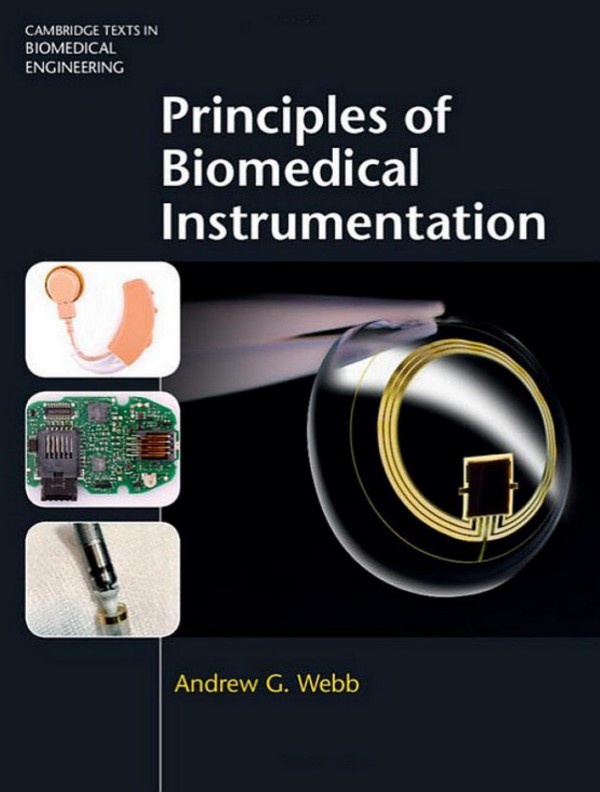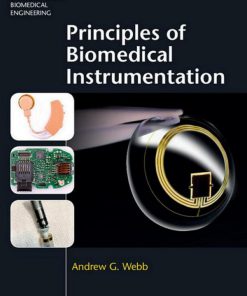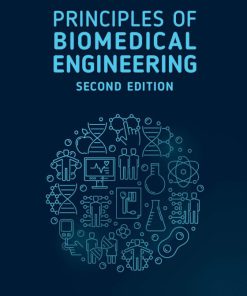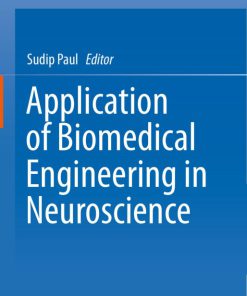(Ebook PDF) Principles of Biomedical Instrumentation 1st edition by Andrew Webb 1108547176 9781108547178 full chapters
$50.00 Original price was: $50.00.$25.00Current price is: $25.00.
Authors:Andrew G. Webb , Series:Biomedical [50] , Author sort:Webb, Andrew G. , Languages:Languages:eng , Published:Published:Apr 2020 , Publisher:CAMBRIDGE UNIVERSITY PRESS
Principles of Biomedical Instrumentation 1st edition by Andrew G. Webb – Ebook PDF Instant Download/DeliveryISBN: 1108547176, 9781108547178
Full download Principles of Biomedical Instrumentation 1st edition after payment.
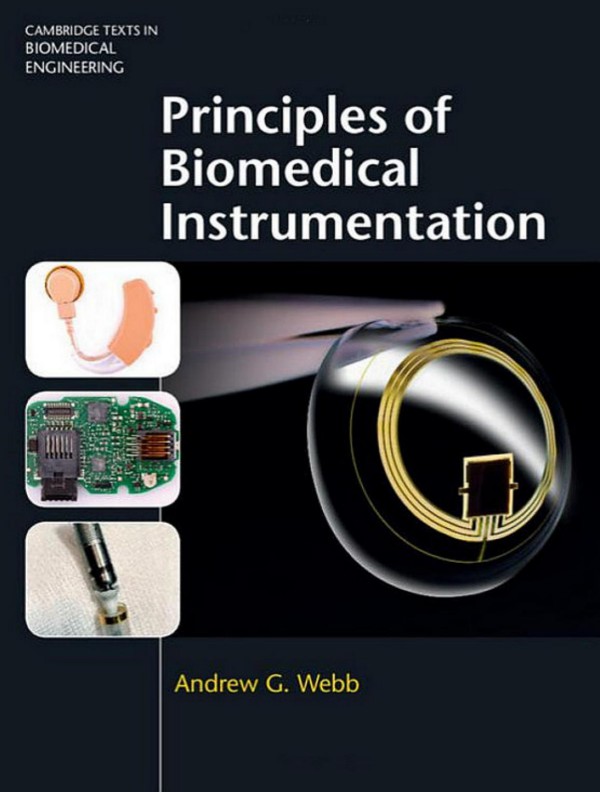
Product details:
ISBN-10 : 1108547176
ISBN-13 : 9781108547178
Author : Andrew G. Webb
This accessible yet in-depth textbook describes the step-by-step processes involved in biomedical device design. Integrating microfabrication techniques, sensors and digital signal processing with key clinical applications, it covers: the measurement, amplification and digitization of physiological signals, and the removal of interfering signals; the transmission of signals from implanted sensors through the body, and the issues surrounding the powering of these sensors; networks for transferring sensitive patient data to hospitals for continuous home-monitoring systems; tests for ensuring patient safety; the cost-benefit and technological trade-offs involved in device design; and current challenges in biomedical device design. With dedicated chapters on electrocardiography, digital hearing aids and mobile health, and including numerous end-of-chapter homework problems, online solutions and additional references for extended learning, it is the ideal resource for senior undergraduate students taking courses in biomedical instrumentation and clinical technology.
Principles of Biomedical Instrumentation 1st Table of contents:
1 Biomedical Instrumentation and Devices
Contents
1.1 Classification of Biomedical Instruments and Devices
1.2 Outline of the Design Process: From Concept to Clinical Device
1.2.1 Engineering Design
1.3 Regulation of Biomedical Instrumentation and Devices
1.4 Safety of Biomedical Instrumentation and Devices
1.4.1 ISO and IEC Standards
1.4.1.1 Hardware
1.4.1.2 Software and User Interfaces
1.4.2 Biological Testing
1.5 Evaluation of a New Device
Problems
References
2 Sensors and Transducers
Contents
Introduction
2.1 Micro-Electro-Mechanical Systems
2.1.1 Noise in MEMS Devices
2.2 Voltage Sensors: Example – Biopotential Electrodes
2.2.1 Clinical and Biomedical Voltage Measurements
2.2.2 Action Potentials and Cellular Depolarization
2.2.3 Surface Electrode Design
2.3 Optical Sensors: Example – a Pulse Oximeter
2.3.1 Clinical Blood Oxygenation Measurements
2.3.2 Measurement Principle Using an Optical Sensor
2.3.3 Optical Transmitter and Detector Design
2.4 Displacement/Pressure Sensors and Accelerometers
2.4.1 Clinical Pathologies Producing Changes in Internal Pressure
2.4.2 Resistive and Piezoresistive Transducers
2.4.2.1 Bridge Circuits
2.4.2.2 Applications of Resistive Sensors in Venous Occlusion Plethysmography and Disposable Blood Pressure Monitors
2.4.3 Piezoelectric Sensors
2.4.3.1 Application of Piezoelectric Transducers in Automatic Blood Pressure Measurement
2.4.4 Capacitive Transducers
2.4.4.1 Application of Capacitive Sensors as Accelerometers in Pacemakers
2.4.5 Inductive Transducers: the Linear Voltage Differential Transformer
2.5 Chemical Sensors: Example – a Glucose Monitor
2.5.1 Clinical Need for Glucose Monitoring
2.5.2 System Requirements for Glucose Monitoring
2.5.3 Basic Detection Principles of Glucose Monitoring
2.5.4 Designing a Portable Device for Glucose Monitoring
2.6 Acoustic Sensors: Example – a Microphone for Hearing Aids
2.6.1 Clinical Need for Hearing Aids
2.6.2 Microphone Design for Hearing Aids
Problems
References
3 Signal Filtering and Amplification
Contents
Introduction
3.1 Frequency-Dependent Circuit Characteristics: Bode Plots
3.2 Passive Filter Design
3.2.1 First-Order Low-Pass and High-Pass Filters
3.2.2 Higher Order High-Pass, Low-Pass, Band-Pass and Band-Stop Filters
3.2.3 Resonant Circuits as Filters
3.3 Operational Amplifiers
3.3.1 Circuit Analysis Rules for Op-Amps
3.3.2 Single Op-Amp Configurations
3.3.2.1 Inverting and Non-Inverting Amplifiers
3.3.2.2 Integrating and Differentiating Amplifiers
3.3.2.3 Buffer Amplifiers
3.3.2.4 Summing and Differential Amplifiers
3.3.3 The Instrumentation Amplifier
3.4 Active Filters
3.4.1 First-Order Low-Pass, High-Pass and Band-Pass Active Filters
3.4.2 Higher Order Butterworth, Chebyshev and Sallen–Key Active Filters
3.5 Noise in Electrical Circuits
3.6 Examples of Signal Amplification and Filtering
3.6.1 Signal Conditioning in the Pulse Oximeter
3.6.2 Amplification and Filtering in a Glucose Sensor
Problems
References
4 Data Acquisition and Signal Processing
Contents
Introduction
4.1 Sampling Theory and Signal Aliasing
4.2 Dynamic Range, Quantization Noise, Differential and Integrated Non-Linearity
4.3 Electronic Building Blocks of Analogue-to-Digital Converters
4.3.1 Sample-and-Hold Circuits
4.3.2 Comparator Circuits
4.3.3 Shift Register Circuits
4.4 Analogue-to-Digital Converter Architectures
4.4.1 Flash ADCs
4.4.2 Successive Approximation Register ADCs
4.4.3 Pipelined ADCs
4.4.4 Oversampling ADCs
4.4.4.1 Principle of Oversampling
4.4.4.2 Delta-Sigma ADCs
4.4.4.3 Digital Filters
4.5 Commercial ADC Specifications
4.5.1 ADC for a Pulse Oximeter
4.5.2 ADC for a Glucose Meter
4.6 Characteristics of Biomedical Signals and Post-Acquisition Signal Processing
4.6.1 Deterministic and Stochastic Signals
4.6.2 The Fourier Transform
4.6.3 Cross-Correlation
4.6.4 Methods of Dealing with Low Signal-to-Noise Data
4.6.4.1 Signal Averaging
4.6.4.2 Moving Average
4.6.4.3 Post-Acquisition Digital Filtering
Problems
References
5 Electrocardiography
Contents
Introduction
5.1 Electrical Activity in the Heart
5.2 Electrode Design and Einthoven’s Triangle
5.2.1 Standard Twelve-Lead Configuration
5.3 ECG System Design
5.3.1 Common-Mode Signals and Other Noise Sources
5.3.2 Reducing the Common-Mode Signal
5.3.2.1 Instrumentation Amplifier
5.3.2.2 Driven Right Leg Circuit
5.3.3 Design of Lead-Off Circuitry
5.3.4 Filtering and Sampling
5.4 Signal Processing of the ECG Signal and Automatic Clinical Diagnosis
5.4.1 University of Glasgow (Formerly Glasgow Royal Infirmary) Algorithm
5.5 Examples of Abnormal ECG Recordings and Clinical Interpretation
The P-Wave is Inverted
The Magnitude of the P-Wave is Much Higher or Lower Than Usual
The P-Wave is Elongated to Longer Than 100 ms and May Have an Additional Peak
The Delay Between the P-Wave and R-Wave is Altered
Change in the Vector Orientation of Maximum QRS Deflection
The ST Segment Amplitude is Higher (Elevated) or Lower (Depressed) Than Normal
Abnormal Shape of the T-Wave
5.6 ECG Acquisition During Exercise: Detection of Myocardial Ischaemia
5.7 High-Frequency (HF) ECG Analysis
Problems
References
6 Electroencephalography
Contents
Introduction
6.1 Electrical Signals Generated in the Brain
6.1.1 Postsynaptic Potentials
6.1.2 Volume Conduction Through the Brain
6.2 EEG System Design
6.2.1 Electrodes and their Placement on the Scalp
6.2.2 Amplifiers/Filters and Digitizing Circuitry
6.3 Features of a Normal EEG: Delta, Theta, Alpha and Beta Waves
6.4 Clinical Applications of EEG
6.4.1 EEG in Epilepsy
6.4.2 Role of EEG in Anaesthesia: the Bispectral Index
6.5 EEG Signals in Brain–Computer Interfaces for Physically Challenged Patients
6.5.1 Applications of BCIs to Communication Devices
6.5.2 Applications of BCIs in Functional Electrical Stimulation and Neuroprostheses
6.6 Source Localization in EEG Measurements (Electrical Source Imaging)
Problems
References
7 Digital Hearing Aids
Contents
Introduction
7.1 The Human Auditory System
7.2 Causes of Hearing Loss
7.3 Basic Design of a Digital Hearing Aid
7.4 Different Styles of Hearing Aid
7.5 Components of a Hearing Aid
7.5.1 Earmoulds and Vents
7.5.2 Microphones
7.5.2.1 Single Directional Microphones
7.5.2.2 Dual Directional Microphones
7.5.2.3 Second-Order Directional Microphone Arrays
7.6 Digital Signal Processing
7.6.1 Feedback Reduction
7.6.2 Adaptive Directionality and Noise Reduction
7.6.3 Wind-Noise Reduction
7.6.4 Multi-Channel and Impulsive Noise-Reduction Algorithms
7.6.5 Compression
7.6.6 Multi-Channel Compression: BILL and TILL
7.6.7 Frequency Lowering
7.7 Digital-to-Analogue Conversion and the Receiver
7.8 Power Requirements and Hearing Aid Batteries
7.9 Wireless Hearing Aid Connections
7.10 Binaural Hearing Aids
7.11 Hearing Aid Characterization Using KEMAR
Problems
References
8 Mobile Health, Wearable Health Technology and Wireless Implanted Devices
Contents
Introduction
8.1 Mobile and Electronic Health: Mobile Phones and Smartphone Apps
8.2 Wearable Health Monitors
8.2.1 Technology for Wearable Sensors
8.3 Design Considerations for Wireless Implanted Devices
8.3.1 Data Transmission Through the Body
8.3.1.1 Choice of Operating Frequency
8.3.1.2 Antenna Design Considerations
8.3.1.3 Data Modulation Protocols
8.3.1.4 Wireless Powering of Implanted Devices
8.4 Examples of Wireless Implanted Devices
8.4.1 Cardiovascular Implantable Electronic Devices
8.4.1.1 Pacemakers and Implanted Cardioverter Defibrillators
8.4.1.2 Cardiac Resynchronization Therapy Devices
8.4.1.3 Implanted Loop Recorders and Haemodynamic Monitors
8.4.1.4 Implanted Pulmonary Artery Pressure Sensor
8.4.1.5 Combining Data From Multiple Sensors
8.4.1.6 New Technologies to Reduce the Risks of CIED Infection
8.4.2 Continuous Glucose Monitors
8.4.3 Implanted Pressure Sensors for Glaucoma
8.5 Packaging for Implanted Devices
Appendix: Reference Standards and Information Related to Wireless Implant Technology
Problems
References
9 Safety of Biomedical Instruments and Devices
Contents
Introduction
9.1 Physiological Effects of Current Flow Through the Human Body
9.2 The Hospital Electrical Supply
9.2.1 Hospital-Grade Receptacles
9.3 Macroshock, Microshock and Leakage Currents: Causes and Prevention
9.3.1 Macroshock
9.3.2 Protection Against Macroshock
9.3.2.1 Isolated Power Systems
9.3.2.2 Ground Fault Circuit Interrupters
9.3.3 Microshock
9.3.4 Protection Against Microshock
9.4 Classification of Medical Devices
9.4.1 Classes of Equipment
9.4.2 Types of Equipment
9.5 Safety Testing Equipment
9.5.1 Leakage Current Measurements
9.5.1.1 Earth and Enclosure Leakage Currents
9.5.1.2 Patient Leakage Current: Normal and F-Type
9.5.1.3 Patient Auxiliary Leakage Current
9.5.2 Earthbond Testing
9.6 Safety of Implanted Devices
9.6.1 Biocompatibility
9.6.1.1 Materials Used in Implanted Devices
Metals
Ceramics
Polymers
9.6.1.2 Biological Testing
Cytotoxicity
Haemocompatibility
Implantation effects
Carcinogenicity
Effects of material degradation
9.6.2 Electromagnetic Safety
9.6.3 Clinical Studies
9.7 Design of Devices That Can Be Used in a Magnetic Resonance Imaging Scanner
People also search for Principles of Biomedical Instrumentation 1st:
principles of biomedical instrumentation webb pdf
principles of biomedical instrumentation webb
principles of applied biomedical instrumentation
principles of medical electronics and biomedical instrumentation pdf
principles of applied biomedical instrumentation pdf

